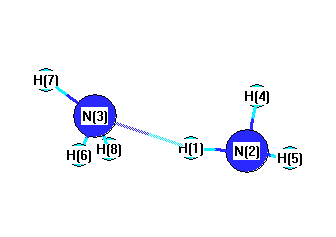Vibrational Frequencies calculated at CCSD(T)/cc-pVTZ
| Mode Number |
Symmetry |
Frequency
(cm-1) |
Scaled Frequency
(cm-1) |
IR Intensities
(km mol-1) |
Raman Act
(Å4/u) |
Dep P |
Dep U |
|---|
| 1 |
Ag |
3588 |
3498 |
|
|
|
|
| 2 |
Ag |
3464 |
3376 |
|
|
|
|
| 3 |
Ag |
1694 |
1651 |
|
|
|
|
| 4 |
Ag |
1138 |
1109 |
|
|
|
|
| 5 |
Ag |
432 |
421 |
|
|
|
|
| 6 |
Ag |
133 |
130 |
|
|
|
|
| 7 |
Au |
3596 |
3506 |
|
|
|
|
| 8 |
Au |
1704 |
1662 |
|
|
|
|
| 9 |
Au |
217 |
211 |
|
|
|
|
| 10 |
Au |
88 |
86 |
|
|
|
|
| 11 |
Bg |
3598 |
3507 |
|
|
|
|
| 12 |
Bg |
1695 |
1652 |
|
|
|
|
| 13 |
Bg |
108 |
105 |
|
|
|
|
| 14 |
Bu |
3588 |
3498 |
|
|
|
|
| 15 |
Bu |
3466 |
3379 |
|
|
|
|
| 16 |
Bu |
1671 |
1629 |
|
|
|
|
| 17 |
Bu |
1117 |
1089 |
|
|
|
|
| 18 |
Bu |
22 |
21 |
|
|
|
|
Unscaled Zero Point Vibrational Energy (zpe) 15658.9 cm
-1
Scaled (by 0.9748) Zero Point Vibrational Energy (zpe) 15264.3 cm
-1
See section
III.C.1 List or set vibrational scaling factors
to change the scale factors used here.
See section
III.C.2
Calculate a vibrational scaling factor for a given set of molecules
to determine the least squares best scaling factor.
